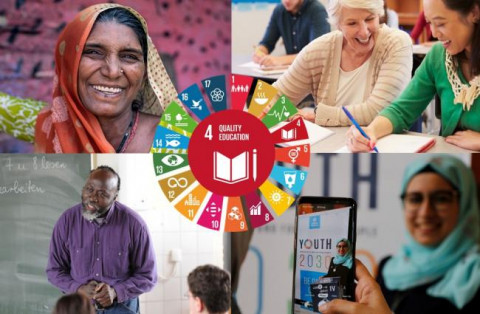
GCED Basic Search Form
Quick Search
You are here
News

Globally, the world is not on track to achieve Sustainable Development Goal 4 (SDG 4), with the risk of leaving hundreds of millions of children, young people and adults behind on every continent in 2030.
Out-of-school rates have stagnated at all levels
- 64 million children of primary school age (6 to 11 years)
- 61 million of lower secondary school age (12 to 14 years)
- 138 million of upper secondary school age (15 to 17 years)
are still denied the right to education and rates are significantly higher in rural and poor households. The rich are five times more likely to complete secondary school than the poor, reflecting an important equity challenge.
According to new projections by the UNESCO Institute for Statistics and the Global Education Monitoring Report, without a radical shift in education policy and investment, more than 220 million children, adolescents and youth will still be out of school in 2030.
Despite progress, many countries are still far from achieving gender parity
- 1/3 have not reached parity in primary education
- 1/2 have not reached parity in lower secondary education
- 3/4 have not reached parity in upper secondary education
Too few are starting early
Evidence shows the benefits of early childhood education and care on well-being and impact of future learning, especially for the most disadvantaged. Participation in organized learning, however, remains far from universal, ranging from under 50% in least developed countries to 95% in Latin American and Caribbean, Europe and North America.

Too few are acquiring a minimum level of education needed to lead healthy lives, secure decent jobs and participate in society
SDG 4 shifts the ambition from previous international commitments by affirming that everyone is entitled to a minimum of twelve years of free and compulsory education. But only half of all adolescents and youth complete secondary school. This figure drops to 18% in low-income countries and 1% for the poorest girls in these countries.

Added to this, 750 million adults – two thirds of whom are women – are illiterate, with the lowest rates in Southern Asia and Sub-Saharan Africa.

Enrolment in tertiary education – essential for gaining advanced skills needed to meet the needs of sustainable development - stands at 38% with large regional variations.

Being in school does not equal learning for all
More than 617 million - six out of ten - children and adolescents worldwide do not achieve minimum proficiency in reading and mathematics. Most of these children are in school, underscoring the urgent need to improve education quality while broadening access so that no one is left behind. Furthermore, disparities in learning start young and widen as children get older or drop out altogether.

Too many teachers lack the minimum required training
Although comparative data on trained teachers needs to be interpreted with caution, lack of teacher training and professional development severely inhibits the achievement of SDG 4. Sub-Saharan Africa faces the biggest challenges, with 50% of teachers with the minimum required training at secondary level, and 64% in primary. This proportion has been declining since 2000, a result of hiring contract teachers without qualifications to cover gaps at lower cost.
School environments are not conducive to learning
Learning environments are not safe and free from violence, school bullying is pervasive across all regions and countries of different income levels, affecting student’s well-being and capacity to learn.
Schools lack the basics for example, in sub-Saharan Africa, less than one half of schools have access to safe drinking water, electricity, the internet, and computers. Furthermore, the lack of appropriate hygiene and sanitation facilities continues to put girls’ education at risk, especially in adolescence.
Educational institutions are also under threat. More than 14,000 attacks have taken place over the past five years across 34 countries on students, personnel and institutions in many parts of the world, highlighting the urgent need for more concerted efforts to make schools safe spaces and protect education.
Strengthening partnerships is vital to support implementation
The 2030 agenda is about solidarity and partnership. Country ownership is a basic principle of the SDGs but the international community has the responsibility to steer the process, provide strategic guidance and coordinated support. The global SDG-Education 2030 Steering Committee and regional committees that are in place provide the foundation for increasing joint action for education in the years ahead – to learn from each other's experiences, develop joint initiatives ensuring complementarity and synergy.

URL:
